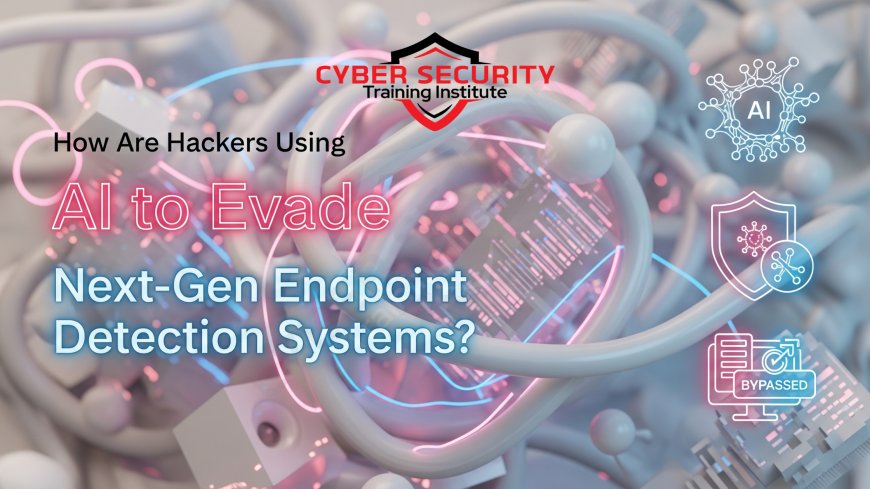How Are Hackers Using AI to Evade Next-Gen Endpoint Detection Systems?
The battle for our computers has become a duel between competing AIs. This in-depth article, written from the perspective of 2025, explores how sophisticated hackers are using their own AI to systematically evade the next-generation, AI-powered Endpoint Detection and Response (EDR) systems that are our best defense. We break down the cutting-edge evasion techniques being deployed: "adaptive mimicry," where malicious AI learns and perfectly imitates the normal behavior of a user to blend in; "adversarial machine learning," where attackers probe a defensive AI to find and exploit its hidden "blind spots"; and the automation of "low-and-slow" attacks that stay under the radar of even the most advanced platforms. The piece features a comparative analysis of defensive EDR techniques versus the offensive AI tactics designed to counter them. It also provides a focused case study on the new risks facing the "work-from-anywhere" tech professionals in hubs like Goa, India, where the endpoint is the new front line. This is an essential read for security professionals who need to understand the new AI-vs-AI arms race happening on our endpoints and why the future of defense lies in the broader context provided by eXtended Detection and Response (XDR).

Introduction: The AI vs. AI Battleground
For the last few years, our best defense against the most advanced cyber threats has been another AI. Next-Generation Endpoint Detection and Response (EDR) systems, powered by sophisticated machine learning, have become the intelligent watchdogs on our company's laptops and servers. They can spot the subtle behaviors of a zero-day exploit or a fileless malware attack that traditional antivirus could never see. But what happens when the intruders learn to speak the watchdog's own language? In 2025, the fight for the endpoint has become a true AI arms race. Attackers are now using their own AI to actively deceive the defensive AI that is trying to hunt them. This is a new class of evasion that targets the very logic of our best defenses, turning the endpoint into the primary battlefield for AI-vs-AI warfare.
The Defender's Brain: How a Next-Gen EDR Works
To understand how attackers are evading these systems, we first need to understand how a "next-gen" EDR's brain works. Unlike old antivirus software that just looked for known file signatures, a modern EDR platform is a behavioral expert. Its core technology is often a form of User and Entity Behavior Analytics (UEBA).
When an EDR agent is installed on a laptop, its first job is to learn. It uses machine learning to build a detailed, granular baseline of what "normal" looks like for that specific device and its user. The AI learns:
- What are the user's typical working hours?
- What applications do they normally run?
- What servers do they usually connect to?
- What kind of scripts does the IT department normally run on the machine?
Once this baseline is established, the EDR's AI watches for any significant deviation. It's not just looking for "bad files"; it's looking for "bad behavior." This is what allows it to detect a brand new, never-before-seen threat. The EDR's intelligent, behavior-focused brain is the attacker's new primary target.
The Attacker's AI: Learning to Be "Normal"
The first and most common way hackers are using AI to bypass EDR is through a technique called "adaptive mimicry." If the defense is based on spotting abnormal behavior, then the attacker's goal is to make their malicious behavior look statistically identical to normal activity. An AI-powered piece of malware, once it compromises an endpoint, will also enter a learning mode. Instead of acting immediately, its own onboard AI will silently observe the system's activity, learning the very same baseline that the EDR agent has learned.
It then uses this knowledge to perfectly camouflage its actions. For example:
- The attacker's AI sees that the company's IT administrators frequently use the legitimate tool `PsExec.exe` to remotely access machines for maintenance every Tuesday at 2 AM. Instead of using its own custom tool for lateral movement, the malicious AI will wait until the next Tuesday at 2 AM and use that exact same trusted tool to make its move.
- To exfiltrate stolen data, the attacker's AI will learn what cloud storage service the user normally connects to (e.g., OneDrive or Google Drive). It will then leak the stolen data out in thousands of tiny, encrypted chunks through that same trusted channel, perfectly mimicking the user's normal upload patterns and speeds.
The malicious AI is effectively using the EDR's own behavioral baseline against it, hiding in the legitimate noise of the system. .
Adversarial ML: Finding and Exploiting the EDR's Blind Spots
This is a more direct and sophisticated attack on the defensive AI model itself. Just like any AI, the machine learning models used in EDR products are not perfect. They have inherent "blind spots"—specific, often obscure, combinations of actions that they have not been properly trained on and which they will incorrectly classify as benign.
An attacker can get a copy of the EDR product they want to target and run it in their own lab. They can then use their own AI to launch an "adversarial machine learning" attack against it. The attacker's AI will systematically probe the EDR's model, trying thousands or millions of different variations of an attack sequence. It is essentially running a high-speed, automated "red team" exercise to find a sequence of events that achieves its malicious goal but does not trigger a high-priority alert from the EDR. Once it finds this "blind spot," the attacker can then craft a new piece of malware that is specifically designed to execute that exact sequence of commands, allowing it to operate invisibly right under the EDR's nose. .
Comparative Analysis: Defensive AI vs. Offensive AI Evasion
The fight for the endpoint has become a true AI-vs-AI duel, with each side developing techniques to counter the other.
| Defensive EDR Technique | Offensive AI Evasion Tactic |
|---|---|
| Behavioral Baselining (UEBA) The EDR learns what is "normal" for a user and their machine to spot anomalies. |
Adaptive Mimicry The attacker's AI also learns what is "normal" and then carefully mimics that legitimate behavior to blend in. |
| TTP Detection The EDR is trained to look for known malicious Tactics, Techniques, and Procedures (TTPs). |
"Low-and-Slow" Execution The attacker's AI breaks down its attack into tiny, individual steps that are spread out over a long period, so no single action triggers a specific TTP alert. |
| Machine Learning Classifiers The EDR's AI model is trained on billions of samples to classify a sequence of events as "malicious" or "benign." |
Adversarial Machine Learning The attacker's AI probes the EDR's model to find a "blind spot"—a specific, malicious sequence that the model incorrectly classifies as benign. |
| Automated Response (Isolation) The EDR can automatically isolate an endpoint from the network when it detects a high-confidence threat. |
Environment-Aware Malware The attacker's AI can detect the initial signs of an automated response (like a diagnostic scan) and can go dormant or self-delete to avoid capture and analysis. |
The Goa Remote Worker: The Endpoint Battleground
The "work-from-anywhere" culture of 2025 has made the individual employee's laptop the primary battleground for these AI-vs-AI fights. Consider a senior software developer for a major Indian fintech company who is working for several weeks from a villa in Bogmalo, Goa. Their corporate laptop is the gateway to the company's most valuable source code and cloud infrastructure. It is protected by a state-of-the-art, AI-powered EDR agent, but it is operating far from the layered defenses of the corporate network.
An attacker who compromises this developer's laptop can deploy an AI-driven evasion agent. The defensive EDR agent on the laptop has learned that this developer's "normal" behavior is actually quite "noisy"—they often use complex scripting tools, compile code, and connect to many different servers as a part of their job. The attacker's malicious AI sees this high-activity baseline and uses it as the perfect camouflage. It begins to move laterally or exfiltrate data, but it does so using the same scripting tools as the developer and at a very slow pace that gets lost in the noise of their normal work. To the defensive AI, this malicious activity is statistically indistinguishable from the developer's normal, chaotic work patterns. The attacker's AI is successfully hiding in the EDR's own blind spot, using the user's legitimate behavior as the perfect disguise.
Conclusion: The Future is XDR and Deeper Context
The fight for the endpoint has become a sophisticated duel between competing AIs. Attackers are no longer just hiding from our security tools; they are actively studying, learning from, and deceiving them with a new generation of intelligent malware. They are using adaptive mimicry, adversarial machine learning, and automated "low-and-slow" techniques to bypass our most advanced behavioral defenses.
The answer to this new threat is not to abandon AI in defense, but to make our defensive AI even smarter by giving it more context. This is the driving force behind the move from Endpoint Detection and Response (EDR) to eXtended Detection and Response (XDR). An XDR platform doesn't just look at the endpoint in isolation. It correlates the subtle, suspicious signals from the endpoint with data from the network, the cloud, email systems, and identity platforms. This broader context is the key to spotting a malicious AI that is trying to hide in the local noise. When the attacker is an intelligent agent, the only effective watchdog is an even smarter agent with an even better vantage point.
Frequently Asked Questions
What is a "Next-Gen" EDR system?
Next-Gen EDR (Endpoint Detection and Response) refers to modern endpoint security platforms that have moved beyond traditional signature-based antivirus and are heavily reliant on AI and machine learning for behavioral-based threat detection.
What is UEBA?
UEBA stands for User and Entity Behavior Analytics. It is the core AI technology that allows a security system to learn the "normal" behavior of users and devices so that it can detect abnormal activity that could indicate a threat.
What is an adversarial attack on an AI model?
It's a technique where an attacker uses their own AI to find a "blind spot" or weakness in a defensive AI model. They craft a specific, malicious input that the defensive AI will incorrectly classify as benign or safe.
What does "low and slow" mean in a cyberattack?
"Low and slow" is a stealth technique where an attacker carries out their malicious activities over a very long period, making very small changes. This is designed to stay below the detection thresholds of security tools that are looking for sudden, noisy activity.
Why is a remote worker in Goa a good example of this risk?
Because their endpoint (their laptop) is the primary battleground. It is operating outside the company's core network defenses, and for certain high-activity users like developers, their "normal" behavior can be noisy, providing the perfect camouflage for a malicious AI to hide within.
What is XDR?
XDR stands for eXtended Detection and Response. It is the evolution of EDR. An XDR platform collects and correlates data not just from endpoints, but from a wide range of other security sources like network, cloud, and email to get a more unified view of a threat.
How can an attacker's AI mimic a user?
By first observing. The malicious AI will watch the user's normal activity—the tools they use, the times they work, the servers they access—and then it will ensure that its own malicious activities use the same tools at the same times to blend in.
What is a fileless malware attack?
A fileless attack is one that runs entirely in a computer's memory and doesn't write a malicious file to the disk. These attacks often use legitimate system tools like PowerShell, and they are a perfect match for AI-driven behavioral evasion.
What is a "blind spot" in an AI model?
A blind spot is a weakness in an AI model where it will consistently make an incorrect prediction or classification for a specific type of input that it was not adequately trained on. Attackers use adversarial ML to find and exploit these blind spots.
What are TTPs?
TTPs are the Tactics, Techniques, and Procedures used by attackers. Modern EDRs are trained to look for the behavioral patterns associated with specific TTPs from frameworks like MITRE ATT&CK.
Is this AI-vs-AI battle happening now in 2025?
Yes. The most sophisticated nation-state and criminal actors are actively developing and using AI-powered evasion techniques, while all the leading EDR and XDR vendors are using their own AI to counter them. It is the new front line of endpoint security.
What does "polymorphic" mean?
Polymorphic malware is malware that can constantly change its own code to avoid detection by signature-based tools. AI is now being used to make the *behavior* of malware polymorphic, not just its code.
What is a "sandbox"?
A sandbox is an isolated testing environment used by security researchers to safely analyze malware. An AI-powered malware can often detect if it is in a sandbox and will hide its true malicious functions.
Can my personal antivirus do this?
Most consumer-grade antivirus products now include some basic behavioral detection capabilities, but they are generally not as sophisticated as the enterprise-grade EDR and XDR platforms that are engaged in this high-level AI arms race.
What is "lateral movement"?
Lateral movement is the technique an attacker uses to move from the initial point of compromise to other machines within the same network. An AI can learn the stealthiest way to do this.
How do you train an AI to be a better defender?
Through a process called "adversarial training," where the defensive AI is intentionally trained against the very evasion techniques that attackers use. This helps it to learn to spot more subtle and deceptive attacks.
What does it mean for a signal to be "correlated"?
Correlation is the process of linking multiple, separate events together to see a larger pattern. An XDR platform might correlate a minor endpoint alert with a network alert and a cloud alert to identify a single, major attack campaign.
What is a "user-agent string"?
It's a piece of text that a browser or other software sends to identify itself to a server. Attackers often change this to try and disguise their malicious tools as legitimate web browsers.
Is there any way to be 100% secure?
No, 100% security is not achievable. The goal of modern cybersecurity is resilience—the ability to rapidly detect, respond to, and recover from an attack to minimize its impact.
What is the biggest advantage of a defensive AI?
Speed and scale. A defensive AI can analyze trillions of events from thousands of endpoints in real-time and make a decision in milliseconds, a capability that is far beyond any human security team.
What's Your Reaction?
 Like
0
Like
0
 Dislike
0
Dislike
0
 Love
0
Love
0
 Funny
0
Funny
0
 Angry
0
Angry
0
 Sad
0
Sad
0
 Wow
0
Wow
0














